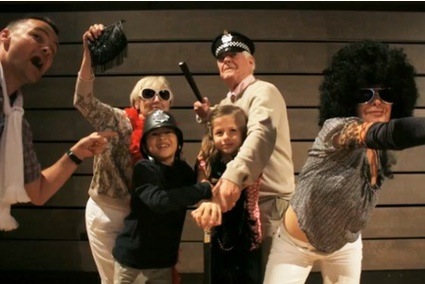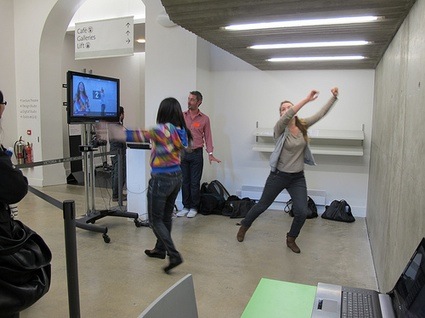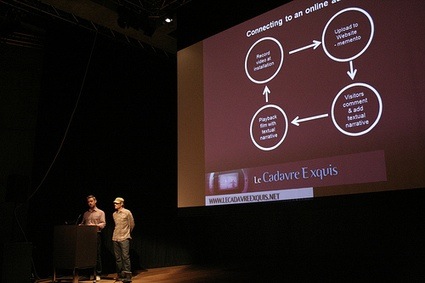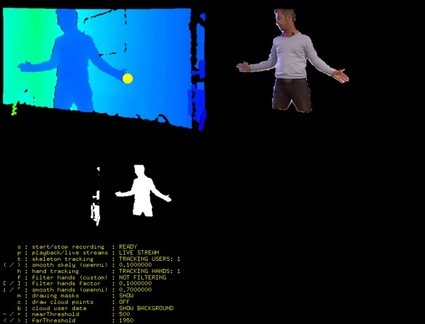
At the beginning of the Summer i was in Nottingham to participate to Making Future Work. That day was only the last of a long string of events, conferences, meetings and commissions.
MFW started back in December 2010 when Broadway -a cinema we shall all salute for its programme dedicated to media arts– called for artists, designers and organisations based in East Midlands to submit proposals that would respond to four distinct areas of practice: Co creation / Online Space, Pervasive Gaming / Urban Screens, Re-imaging Redundant Systems and Live Cinema / 3D.
The winning projects were therefore very different from each other. Hopefully, their quality will put East Midlands on the digital art/interaction design map.
One of the winning proposals is Le Cadavre Exquis, a digital re-interpretation of the surrealist game Exquisite Corpse and the parlour game Consequences in which participants define parts of an image or text. The next person will add a portion of text or image without having seen the previous one and the process repeats itself until a complete narrative or image is completed.
In the interactive installation designed by Brendan Oliver and Brendan Randall, members of the public are invited to record a short stop-frame animation (with a little help from a custom designed software and gesture interface) as a response piece to a previously recorded submission. The piece is uploaded online within minutes and textual narrative is then created by online participants through a narrative suggestion feature.
Le Cadavre Exquis’ aims to explore how notions of co-creation and user-engagement in live/on-line spaces, within the context of digital art or digital interaction, can be used to create an ever-growing visual film generated entirely by participants.
Contemporary sources of inspiration include user-generated content projects such as Aaron Koblin’s wonderful The Sheep Market and The Johnny Cash Project, a crowd-sourced music video initiated by Chris Milk. I had never seen it before Brendan Oliver and Brendan Randall screened it in Nottingham so let me copy paste the embedded code over here:
I thought i should catch up with Oliver and Randall to see how the installation had evolved and traveled since we met in Nottingham.
The call for proposals invited artists and designers to respond to “four distinct areas of current practice” in digital innovation. You chose to focus on ‘Co creation.’ But did you have this particular project of Le Cadavre Exquis in mind well before reading about the commissions or did you start from scratch when you read the commission guidelines? How did the project mature and evolve?
Whilst we have an interest in co-creation and user-generated content the actual concept of Le Cadavre Exquis was generated completely as a response to the call for submissions and wasn’t something we were already working on. When we read the briefs we considered them all and potential responses to each before deciding to submit a proposal for “Live Cinema and Co-Creation”. It was at this stage the concept of Le Cadavre Exquis was born.
Initially the concept was that participants would respond visually to a textual narrative set by the previous participants and this would serve as the basis for them to act out their own submission. Once they had completed their submission they would then set the textual narrative for the next participants (using a keyboard) and by doing so we would have an entirely user-generated linear visual and textual responsive narrative.
However, through our research and development of the installation, we realised that this approach was very restrictive for participants and by allowing participants to dictate the visual and textual narratives the quality of the final outcome would be less successful than if we allowed participants to be responsive. We came to this conclusion for two main reasons. Firstly, we felt by having participants provide a textual narrative as well as record their visual submission this was too immersive and time consuming for an installation environment. Secondly, there was also the possibility that people would feel they could not respond to the textual narrative for varying reasons such as the narrative being purposefully difficult to respond to or controversial. We also wanted the focus of the installation to be on the creativity and expression in the visual submissions and for the technology to be almost invisible to them. It was always the aim to create tools that empowered the participant in the creative or artistic process and not for them to focus on the technology.
 Le Cadavre Exquis at the V&A’s Web Weekend Image credit: Rain Rabbit
Le Cadavre Exquis at the V&A’s Web Weekend Image credit: Rain Rabbit
Is there any way for the public to check out the archives of the stop frame animations done by other people in the past?
All submissions can can be viewed online on the project website at www.LeCadavreExquis.net as well as textual narratives added to each video created. Visitors to the website can become participants themselves by submitting their own textual narratives to describe scenes filmed within the installation space via the ‘Participation’ page at www.lecadavreexquis.net/participate/. This also introduces a competitive element where visitors can vote for submitted textual narratives. Where more than one textual narrative has been submitted for a clip the narrative with the most votes then becomes the narrative for that video submission.
“Upon completion of the animation the players provide the next line of the dialogue for future player”. How is it done exactly? Do they have to type the scenario on a computer? What is this step like exactly? Does it mean that in the end, if you put the short animations side by side the public has constructed a long collaborative narrative?
This was the original idea and the collaborative narrative is still at the heart of the final installation but we decided to allow participants to respond to the previous visual narrative rather than have them respond to a dictated textual narrative.
The original concept meant that only visitors to the physical installation would be able to take part and to view the output. However, our research-based conclusions, helped us to consider opening up the installation to an online audience.
In the final installation we separated the visual and textual narrative submissions to make it easier for participants to be creative with the visual story and to include an online audience by asking them to add a textual narrative via the website developed for the project. Animations created at the installation were compiled into video files and automatically uploaded to the website where they can be viewed by visitors and textual narratives submitted online. The textual narratives were then pulled back down from the website and displayed as subtitles when the visual narrative is projected in the installation space as a playback aspect.
You probably spent a great deal of time and energy on LCE so are you not ever tempted to influence the public? To ask them to perform in a certain way? Is it not frustrating to let everything in the hands of the strangers?
We did spend a lot of time developing the installation and website, much more than we initially envisioned and was originally considered for the commission. It was always our aim to create something where the final outcome was created solely by the audience and participants. We empowered participants to do this through the technology and the concept of Le Cadavre Exquis. We very much see the installation as a tool for creativity rather than prescribing the creative aspect itself. We are very much interested in how participants respond and in particular how we can enable people who wouldn’t ordinarily consider themselves creative to lose their inhibitions, get excited, have fun, enjoy the experience and become the artist. Due to these ideals its not been frustrating for us to let participants create whatever they like.
I’m quite curious about the way people use LCE. Do they feel immediately at ease with the installation? Do they find it easy to engage with it? Do they reflect a lot before using it? Are they bold? But also did they surprise you along the way? Did they find ways of using the installation you had not thought about before?
Whilst we had introduced the installation at The Nottingham Contemporary for the final commission presentation we were thrown in at the deep end to a certain degree with being invited to install the piece at the V&A some two days later. We had naturally tested the technology and had also experimented was a local Dance company but the V&A would be the first public acid test. So naturally we, whilst confident, were a little nervous as to how the installation would be received. We needn’t have worried though as from the first person to the last seemed to have no problems at all interacting straight away. We had worked very hard to ensure that the technology was very easy to use and understand and this was proved to be the case. With the event being at the V&A there was lots of people from various countries all over the world attending. Even those with little or no English seemed to have no problem understanding how the installation worked and how they could be creative.
As far as installations go this is quite an immersive experience for people to be involved with as we’re asking them to be creative on the spot and to try and lower their inhibitions. Some people have been reflective, a few declined but the overwhelming majority have been excited and more than happy to be involved in something creative and user-generated. Having the playback projection aspect where people entering the space could see all the previously recorded scenes definitely helped in this respect. We think feeling they are part of a larger whole, part of the creative process has been a great incentive and we have been really surprised at the variation and quality of the stories told within the ten frames of the animations they create. You’d be surprised what can be done. We even had a meeting of a couple, courting, engagement, marriage and finally the birth of a baby – all in ten frames.
The beauty of the installation is that because we haven’t sought to control the output it can be used in various ways. For instance The Nottingham Contemporary, who hosted the installation after the V&A, provided a number of props and accessories for participants. This has been great for creative submissions but also influenced the public towards certain narratives by the style of the props themselves and the fact they had tied it into the on-going Jean Genet exhibition at the gallery.
 Brendan Oliver & Brendan Randall presenting Le Cadavre Exquis at Making Future Work in Nottingham. Image credit: Melissa Gueneau, courtesy MFW
Brendan Oliver & Brendan Randall presenting Le Cadavre Exquis at Making Future Work in Nottingham. Image credit: Melissa Gueneau, courtesy MFW
The work has traveled to V&A in London and other venue since we met in Nottingham in June. Do you have plans to show it elsewhere?
Do you plan to develop or modify the piece in the near future?
It’s been quite non-stop for Le Cadavre Exquis being in the V&A two days after completion and directly following that it has been running permanently in The Nottingham Contemporary over the summer. It’s due to finish there on the 4th of September. Our vision is that this is an installation that, in theory at least, can keep running and running. If we can keep installing and generating submissions there’s no reason this can’t be the case. We’ve already had enquiries for installing in various other environments and alternative uses. We are very much open to propositions or proposals from anywhere & anyone.
By the very nature of how the installation is conceived we can adapt the system in many ways to different uses and environments from performance to education uses. We also have plans to develop the project using the generated content itself. One area we’re looking into is a ‘Director’ tool aspect where online users will be able to access all the videos and textual narratives (or indeed write their own) to create their own self-directed movie. We’re currently looking into funding opportunities to develop this aspect. This notion of ‘Directing’ has routes into performance and writing within the arts and education – all of which is very exciting for us and for the project in the future.
Thanks Brendan and Brendan!
Photo homepage: Le Cadavre Exquis at the V&A’s Web Weekend programme Credit: Rain Rabbit.

 The
The